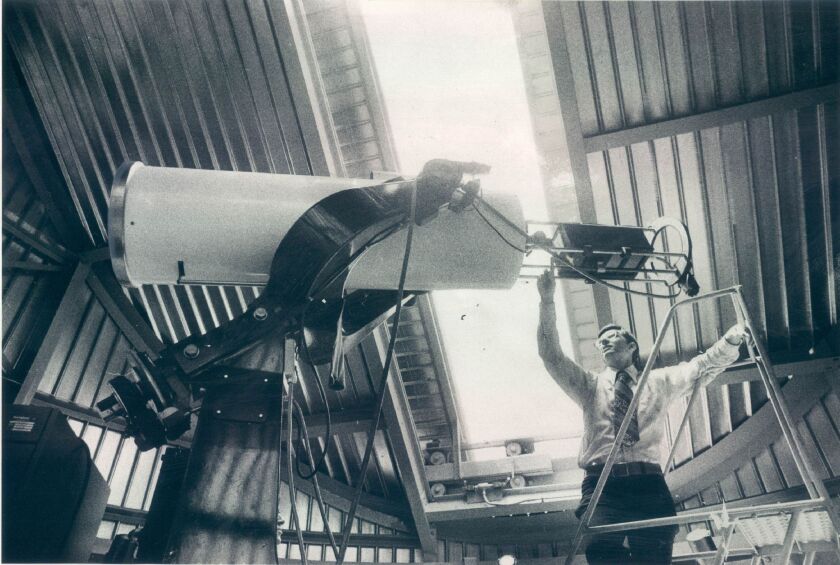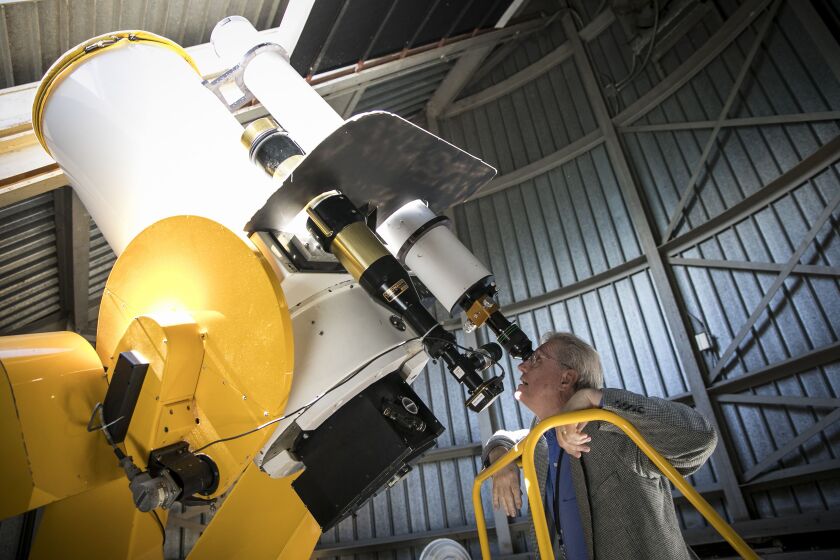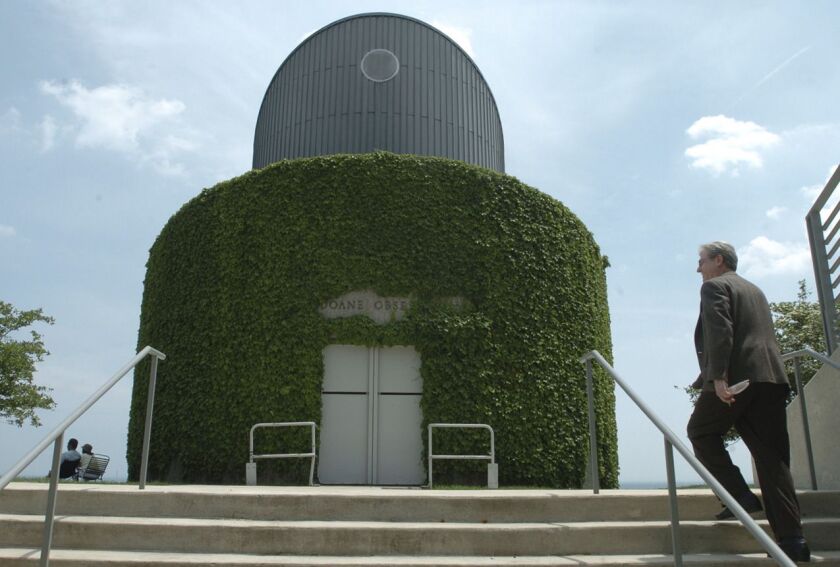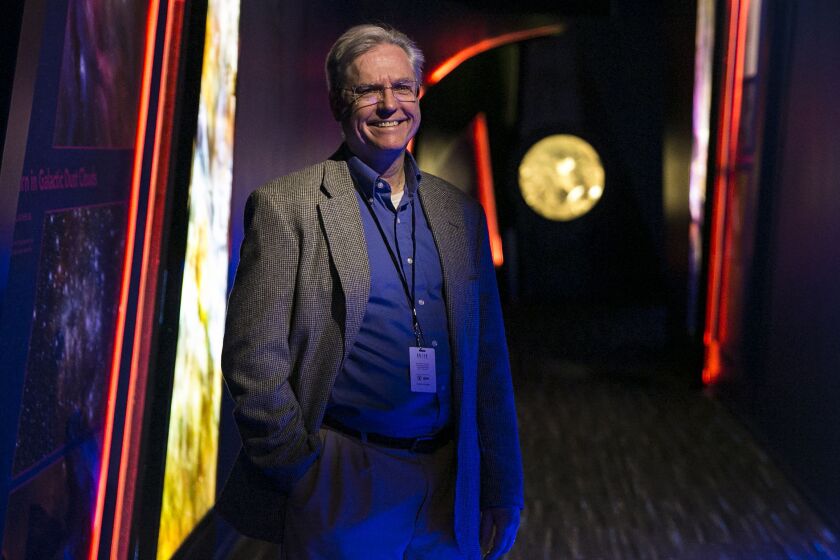Larry Ciupik is like a human exclamation point.
His salt-and-pepper eyebrows shoot up at the least provocation. He has an explosive laugh, and he’s forever flinging his hands to emphasize a point.
The 68-year-old Adler Planetarium astronomer can’t help himself. His enthusiasm for his life’s work remains undimmed almost 46 years after he started there.
“I’m kind of rambling a bit because there is just so much to say!” said Ciupik, speaking with preacher-like zeal on a tour of the Adler last week.
Ciupik will make his final 2 1/2-hour daily commute from the northwest suburbs to the Adler in early August, when he plans to retire.
In the meantime, you might find Ciupik sorting through the clutter in his tiny office within the labyrinthine basement of the Adler. It has no windows, which seems almost cruel for a man who studies the universe, and every few minutes a CTA bus rolls overhead, rattling the fluorescent ceiling fixture.
For four-plus decades, when he’s not researching supernovas and black holes, Ciupik has tried to get Adler visitors to see beyond their workaday world and think big thoughts about space.
“You’re thinking about the origins, you’re thinking about what’s your place in the universe. Why are you here?” he says.
He’s helped visitors understand everything from the Hubble Telescope to the returning Halley’s Comet and Pluto’s demotion — as well as the highs and lows of the space shuttle program.
At the same time, he’s constantly stressing the real-life value of space technology. And not just Tang and Velcro.
In 1981, federal agents showed up at his office. They needed Ciupik’s help solving a crime. The brother of a West Side man charged with passing counterfeit money was claiming the feds had the wrong guy. To prove it, the brother produced a photograph of the accused posing with his mom on Mother’s Day — at the time and day when the crime was supposedly committed, the brother said. Measuring the length and position of the shadows, Ciupik testified in court that the photo couldn’t have been taken on Mother’s Day. Ciupik’s testimony helped lead to a conviction, although it was later overturned on appeal.
“It’s actually been used as a teaching tool for other lawyers,” Ciupik said, calling his work “forensic astronomy.”
Ciupik, who grew up in Park Ridge, felt the pull of the sky when he was about 10. A friend of Ciupik’s father gave him a stack of books about Galileo, Einstein and the nature of the universe.
“By early high school, I was just hooked on astronomy,” he said. He was in the astronomy club at Maine South High School. He built his own telescope, grinding and polishing the mirror for it in his parents’ basement.
At the Adler, peering into an eyepiece and scanning the sky is a very small part of what Ciupik does. Each morning, after his banana and coffee, he checks his email, seeing what’s new in the astronomical world. He replies to questions from the public. He meets with a handful of observatory volunteers who will be keeping an eye on the sun to check for sunspots or other activity.
And he gives tours. On this day, as he leads visitors through the maze-like Adler — past groups of squealing kids and through darkened exhibit spaces with pulsing colored lights — he’s asked to point out his favorite things. Almost two hours later, he’s still at it.
“There’s a lot of funny stories. Do you have time?” he says at one point.
He pauses in front of a pitted, blackened hunk of rock about the size of a softball.
In 2003, a meteorite hurtled through the earth’s atmosphere, a chunk of it smashing through the roof of an Olympia Fields home, and ending up in the basement.
“This was one of my proudest moments because [the home owners] called their insurance, they called the police and they called me,” Ciupik said.
There are stops in front of vintage telescopes — one, with a mahogany tube and polished metal mirror, built by William Herschel about the time of the American Revolution. Through the lens of its twin, Herschel — a German-born Englishman — discovered the planet Uranus, although he named it after his sponsor, King George III.
Another tour must-see: the tiny, scorched Gemini 12 capsule, which spent five days orbiting the earth in 1966 with astronauts Jim Lovell and Buzz Aldrin inside. It appears there’s barely room inside for each astronaut to wiggle a toe.
“We are worried about being bored today, but imagine you’re flying around the world for five days with your buddy,” Ciupik says. “You’re either good friends or not-so-good friends afterwards. They couldn’t move.”
Through the years, Ciupik says he’s often been asked the question you’d most expect: Is there life beyond our planet?
He’s a science guy. So he prefers to stick with the evidence, he says.
“Maybe there are other aliens — maybe God is an alien,” he says, half jokingly.
Turns out, he does believe in God — sort of.
“I believe in a supreme being,” he says. “It’s not a traditional religion. … Unseen but controlling things for us.”
Though he’s thrilled at private ventures to send people into space, he won’t be going himself, he says.
“I don’t do well at carnivals,” he says. “So, no, I don’t regret not being in zero [gravity].”
He says his last day really is going to be August 4 — he’s put off retirement several times. And while he says he wants to do other things — hike, travel and plant flowers with his wife — he plans to return to volunteer and share what’s he’s learned in the last 40 years.
And perhaps it’s not so difficult to understand why.
“I’ve had people sitting down on the floor in the observatory crying because they’ve just seen Saturn for the first time,” he says.












